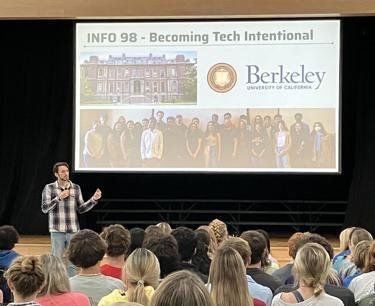Volunteer uses her incredible singing voice to comfort dying patient on 'final journey home'
The woman requested her and her husband's favorite song, "The Power of Love."

What a beautiful way to show up for others.
There's something really magical about what music does to our brains. Have you ever found yourself remembering a commercial jingle you haven't heard in decades? Or have you ever wondered why you can't remember what you ate yesterday but you can recite the lyrics of thousands of songs on-demand without even thinking?
If you've ever seen the end of the 2017 Disney movie Coco, you also know that music can trigger memories, emotions, a boost of energy, and even joy in people who are otherwise nearly unresponsive or have lost much of their will to go on. And if you're thinking that was just an incredibly emotional moment in a sweet movie, it's true; science backs it up. That makes it an amazing and mysterious therapeutic tool in medical settings, and an incredible way to comfort people who may be scared or confused.

Yvon Kanters, a social worker, has been volunteering in nursing homes for years. She has gone viral for her incredible interactions with patients, where she uses her beautiful voice to connect with them and bring them joy in dark moments.
In one recent video, Kanters is shown riding in the back of an ambulance with a woman on a stretcher. The woman is a cancer patient who had just been told by doctors that there was no further treatment available. This would be her last ride home from the hospital. Kanters volunteered to come along and sing the woman a song for comfort.
"When we walked into the room, she was there with her husband and was very optimistic, she was very full of life," Kanters told Newsweek. "We brought her to the ambulance and then asked her, 'I'm a singer and I'm coming along for the day, is there something you want to hear?' She and her husband, they love each other—their love is so visible. She said she and her husband's song was 'The Power of Love.'"
"The Power of Love," of course, is the hit single by Jennifer Rush from 1984. The next year year, it became the number one song in the UK. A cover by Celine Dion years later made it the biggest song in the US. It's an incredibly romantic song, and it speaks volumes about the woman's life that she would choose to hear it at this moment.
"As I sang, I saw tears well up in her eyes. A song that held so much more meaning than just words and melody. After this moment, we continued with a small, intimate living room concert... one that will stay in my heart forever," Kanters said.
Watch the incredible moment here:
@yvonkanters 𝗧𝗛𝗘 𝗣𝗢𝗪𝗘𝗥 𝗢𝗙 𝗟𝗢𝗩𝗘 | 𝗠𝗲𝗲 𝗼𝗽 𝗱𝗲 𝗮𝗺𝗯𝘂𝗹𝗮𝗻𝗰𝗲 𝗺𝗲𝘁 𝗭𝘂𝘀𝘁𝗲𝗿 𝗔𝗻𝗶𝘁𝗮 Sommige ontmoetingen blijven je altijd bij. Gisteren zong ik voor een bijzondere vrouw, een vechter vol levenslust. Ze werd door Zuster Anita van de middencomplex ambulance naar huis gebracht om haar laatste tijd met haar geliefden door te brengen. Geen spoedrit, maar een rit vol betekenis. Ze hield van álle muziek, maar toen ik vroeg of ze een speciaal liedje had samen met haar man, hoefde ze niet na te denken: "The Power of Love." Terwijl ik zong, zag ik de tranen in haar ogen verschijnen. Een lied dat zoveel meer betekende dan alleen muziek. Na dit moment deden we nog een klein huiskamerconcert.. een herinnering die voor altijd zal blijven. Dankjewel Zuster Anita, en dankjewel aan deze prachtige vrouw voor het delen van dit bijzondere moment. Liefde is de kracht die blijft. 💛✨ #ThePowerOfLove #AmbulanceZorg #MiddencomplexAmbulance #MuziekVerbindt #LiefdeEnVerbinding #MuziekInDeZorg #Muziektherapie #YvonKanters ______________________________ 𝗧𝗛𝗘 𝗣𝗢𝗪𝗘𝗥 𝗢𝗙 𝗟𝗢𝗩𝗘 | 𝗢𝗻 𝘁𝗵𝗲 𝗔𝗺𝗯𝘂𝗹𝗮𝗻𝗰𝗲 𝘄𝗶𝘁𝗵 𝗡𝘂𝗿𝘀𝗲 𝗔𝗻𝗶𝘁𝗮 Some encounters stay with you forever. Yesterday, I sang for a remarkable woman, an fighter full of life. She was being transported home by Nurse Anita and the mid-complex ambulance, a service for patients who need medical supervision but no emergency care. No sirens, but a journey filled with meaning. She loved all kinds of music, but when I asked if she had a special song with her husband, she didn’t hesitate: "The Power of Love." As I sang, I saw tears well up in her eyes. A song that held so much more meaning than just words and melody. After this moment, we continued with a small, intimate living room concert.. one that will stay in my heart forever. Thank you, Nurse Anita, and thank you to this beautiful woman for sharing this moment with me. Love is the power that never fades. 💛✨ #ThePowerOfLove #AmbulanceCare #MidComplexAmbulance #MusicUnites #HealingThroughMusic #MusicTherapy #YvonKanters
Over four million people watched the video and couldn't get enough of the kindness and compassion on display.
Commenters were absolutely stunned:
"It’s the most beautiful thing I saw today"
"this needs a warning, I'm at work crying"
"oh my god what a wonderful way to go"
"The look of love, care and compassion in this young lady’s eyes for her fellow human - beautiful"
"former hospice nurse here.. I absolutely love this!"
Music is an amazing tool for patients who are near death or suffering from severe dementia. It lives in parts of the brain that are usually less affected by Alzheimer's and dementia, often making music memories the last "to go" as brain function and bodily systems fail.
Even younger people with great memory loss have been shown to remember how to play music or sing lyrics or even dance despite not knowing the names of their loved ones. This phenomenon, crucially, is not just a novelty. It's a proven tool that caregivers use to connect with their patients. Studies show that mood and engagement actually improves in patients after hearing and interacting with music, not just during.
Live music, too, carries a special power. Having a real human being singing to you stimulates the brain more powerfully than listening to recorded music does, forming a unique connection between performer and audience that a speaker can't replicate.
@yvonkanters AVE MARIA | Rudy (English below) Ik ben net zo fan van Rudy als jullie! Daarom wil ik dit prachtige gebed ook laten horen. Rudy heeft in zijn leven veel steun gehad aan muziek. Het was zijn manier van communiceren naar de buitenwereld. Het is een manier van luisteren en antwoorden op elkaar. Dat vind ik ook heel duidelijk te zien aan hem. Hij luistert zo bijzonder goed naar het notenbeeld en wat er gaat komen. Daarop reageert hij weer. Het is een dans van woorden in het Latijn. Een prachtige verbinding en kippenvel. Dank Rudy ♥️ #zingen #dementie #liefde #zorg #fyp #viral #avemaria #gounod #muziektherapie #muziek ———————— AVE MARIA | Rudy I'm just as much of a fan of Rudy as you are! That's why I want to share this beautiful prayer. Rudy has had a lot of support from music in his life. It was his way of communicating to the outside world. It is a way of listening and responding to each other. I think that is very clear in him. He listens very well to the notes and what is to come. He then responds again. It is a dance of words in Latin. A beautiful connection and goosebumps for me. Bless his soul♥️ #singing #dementia #love #care #fyp #viral #avemaria #gounod #musictherapy #music
In another clip from Kanters, she sings "Ave Maria" to an elderly man with dementia who miraculously perks up and even manages to sing along. It's incredible to watch, and it demonstrates that we're really just beginning to scratch the surface when it comes to the power of music as a therapeutic tool.
But for now, it's just amazing and heartwarming to watch a beautiful moment between a volunteer artist and someone in need.


 Joyful moments captured: A cheerful day out!
Joyful moments captured: A cheerful day out! Two generations connecting through their smartphones.
Two generations connecting through their smartphones. Elderly man working.
Elderly man working. A woman in a shower cap.Canva Photos
A woman in a shower cap.Canva Photos A healthy coat of dirt.
A healthy coat of dirt. Maybe cool it on the hot showers. Canva Photos.
Maybe cool it on the hot showers. Canva Photos. An 18-year-olds remaining time, in months.via TEDx
An 18-year-olds remaining time, in months.via TEDx Dino Ambrosi speaks at a school assembly.via Dino Ambrosi (used with permission)
Dino Ambrosi speaks at a school assembly.via Dino Ambrosi (used with permission) A teen boy looks at his phone in bed.via
A teen boy looks at his phone in bed.via